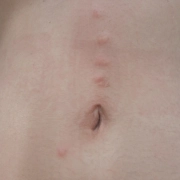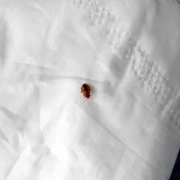BEDBUG INFESTATION: A QUICK OVERVIEW
Did you know that bedbugs can leave bites that look like they came from a spider? They wait until night to attack, when you are in a deep sleep, and chances are, you won’t feel a thing!
They are called little vampires, but even though bedbugs can’t fly (unless they catch a ride on a bat, yes, that really happens), they do love drinking the blood from warm-blooded animals like humans.
They are about 4-5 millimeters long and have a reddish-brown color (which comes from your blood). They don’t like the light and are great at hiding, such as in a mattress, box spring, bed frame, and other areas close to a sleeping person.
These bloodsuckers inject you with a numbing solution and then use their mouth parts to drink your blood. If they feed on you when you toss and turn while sleeping, the bedbug will move and feed on a different part of your body, usually close to where they started. This is why there are lines and clusters of bites when bitten by a bedbug.
Identifying bedbug infestations
Bedbugs are so small and reclusive that they are hard to find. The sooner you find bedbugs, the better because they multiply fast, and you can end up with an infestation quickly without successful extermination.
You’ll look for signs such as small black or brown droppings (they look like marker stains), shed skins (casings), and tiny white eggs (like rice) in and around bedding, furniture, and other hiding spots.
Look at these pictures of bed bug infestations to help you find or confirm an infestation.
The Five Stages of a Bedbug’s Lifecycle
Bedbugs undergo five developmental stages, known as nymph stages, before adulthood. They require a blood meal to molt during each stage and progress to the next step. This process takes around 4-6 weeks, depending on temperature and food availability.
Reproduction and growth
In her lifetime, a bedbug can lay hundreds of eggs, each measuring around 1 millimeter in length. The eggs typically hatch within 6-10 days, and the newly emerged nymphs immediately seek a blood meal.
SIGNS OF A BEDBUG INFESTATION
Physical evidence
One of the most reliable signs of an infestation is bedbugs, dead or alive. Carefully inspect your mattress, bed frame, and surrounding areas for these tiny, flat, reddish-brown pests.
Bites and skin reactions
Bedbug bites are another common indicator of an infestation. These bites often appear as small, red, itchy welts in a line or cluster. Not everyone reacts to bedbug bites, so the absence of bites doesn’t necessarily mean there are no bedbugs.
Unpleasant odor
In severe infestations, bedbugs may produce a distinct, musty odor, often compared to the smell of wet, moldy clothing or shoes. This smell comes from the bugs’ scent glands and is more noticeable when many bedbugs are present.
HOW BEDBUGS SPREAD
Travel and Transportation
Travel is the most common way bedbugs spread. They do it by hitching a ride on luggage, clothing, and personal belongings, allowing them to infest new locations. Always inspect your accommodations and belongings while traveling to help prevent bringing bedbugs home.
Second-hand items
Purchasing second-hand furniture, clothing, and other items can also introduce bed bugs to your home. Inspect and clean any used items before bringing them indoors, especially if they’ve been in storage or previously belonged to someone with a known bedbug infestation.
Shared living spaces
Bedbugs can easily travel between apartments or rooms in shared living spaces, such as apartment buildings, dormitories, and hotels. Proper pest management and communication between residents and building management can help prevent the spread of infestations.
PREVENTING BEDBUG INFESTATIONS
Regular inspections
Routine inspections of your living space are essential for preventing bedbug infestations. Check your mattress, bed frame, and surrounding areas for signs of bedbugs. Be vigilant when returning from travel or bringing new items into your home.
Protecting your home
Taking steps to protect your home from bed bugs can also help prevent infestations. Use mattress and box spring encasements to create a barrier against bedbugs and seal any cracks or crevices in walls and furniture where they might hide.
Safe travel practices
When traveling, inspect your accommodations for signs of bedbugs, and store luggage on luggage racks or elevated surfaces to minimize the risk of infestation. Keep your belongings in sealed plastic bags, and launder your clothes when you return home.
HOW TO GET RID OF BEDBUGS
DIY treatments
If you have bedbugs, you can use a treatment of Diatomaceous Earth (aka bed bug dust, mother earth, and bug bug powder). Using over-the-counter insecticides can be dangerous if misused.
A bedbug bomb or spray can cause the bugs to scatter, making the infestation more challenging to control if not done correctly. While vacuuming, laundering, and steam cleaning, can help reduce the number of bedbugs, they are unlikely to eliminate an infestation.
Check out these step-by-step instructions on how to get rid of bed bugs and possibly save yourself thousands of dollars!
Professional extermination
Hiring a pest control company can be challenging as you’ll have to wash, pack, and move items, but they have the experience to get the job done right. The right exterminator can help you eliminate the infestation, but it has to be a team effort, or you’ll end up frustrated.
Post-treatment precautions
After treatment, it’s crucial to remain vigilant and take precautions to prevent a re-infestation. Regularly inspect your home, maintain preventative measures such as encasements, and seal any cracks or crevices.
Bedbug infestations are an unpleasant and challenging problem to deal with. You can effectively combat these persistent pests by understanding the signs of infestation, taking preventive measures, and seeking professional help when necessary. Early detection and prompt action are critical to preventing their spread and protecting your home.
Many exterminators will tell you that DIY home treatment does not work, but that IS NOT true. The reason behind most home treatment failures is not sticking with the plan! It is a long process, but you can do it yourself if you stick with it.

